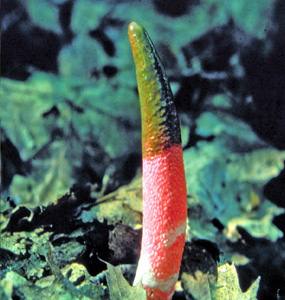Mutinus elegans

Image Courtesy of Peter Katsaros
| Click to Enlarge |
| Click For Image Gallery |
|
Group of Fungi: Stinkhorns Family: Phallaceae Latin Name: Mutinus elegans (Mont.) Fisch. Common Name: Elegant Stinkhorn Description: Total height 4–7 in (10–18 cm) and 5/8–1 in (1.5–2.5 cm in diameter; cylindrical to spike-shaped structure, tapering upwards to a blunt tip with a small central opening, deep pinkish-red above and pale to almost white below, hollow; upper third covered at first by a olive-brown slime mass that is gradually lost; the base surrounded by a sac-like white volva; entire structure developing from an egg-like stage that superficially resembles a puffball; spores hyaline but embedded in an olive-brown slime mass. Biological Role: Decomposer of dead plant material, including both wood debris and leaf litter. Habitat: On the ground in broadleaf forests but also common in urban areas on wood chips and mulch; occasionally solitary but usually occurring in small groups. Geographical Distribution: Found throughout eastern North America. Comments: Mutinus caninus is very similar in appearance but has a spore mass that is confined to a smaller area of the upper portion of the fruiting body and the main axis of the latter is largely white below the spore mass. Like other stinkhorns, the spores of Mutinus elegans are produced in slimy mass that has a foul odor. The odor attracts flies and other insects, which feed upon the slimy mass and then carry some of the spores away. Surprisingly, some people consume this fungus when it is still in the "egg" stage. |
| Go Back |